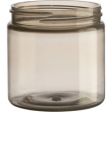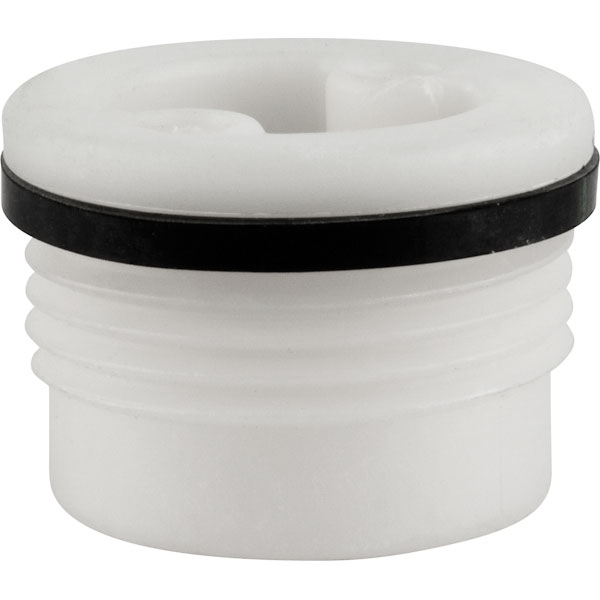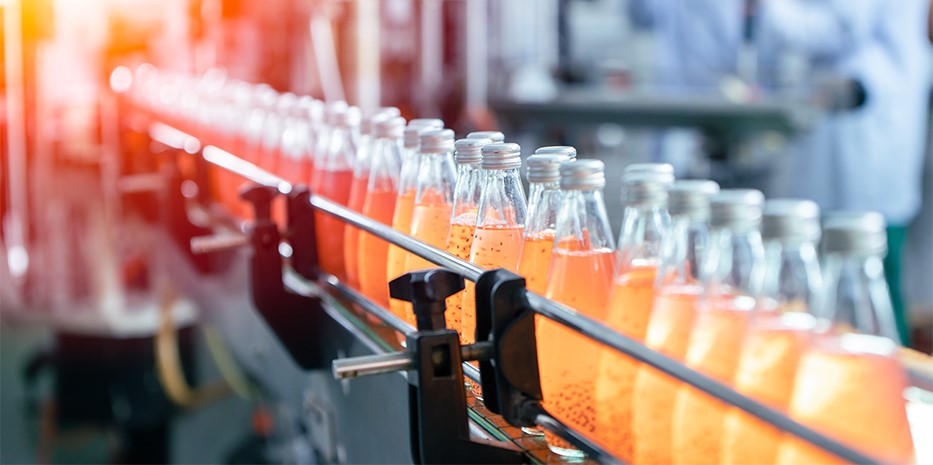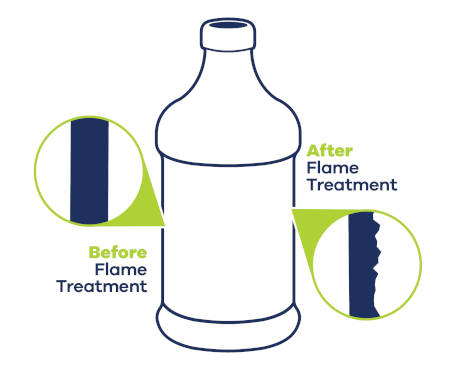
A Complete Guide to Plastics | Types, Uses, & Identification


A Comprehensive Guide to Plastics
Plastic as a material can be versatile for packaging and containers ranging from bottles and lids to totes and drums. Additionally, it is a popular choice across multiple industries. From HDPE to PP, it is important to understand the different types of plastics and how they can work with your product or business. This guide details what each plastic is, some common uses and how to identify each one.
Identifying Plastics
At first glance, it can be difficult to determine what kind of plastic a container is made from. To make it easier for users to identify the item's material, manufacturers have a system in place near the bottom of the bottle, jar, tote, etc. with a certain symbol.
This symbol on plastic containers is a chasing arrow around a number that can range from one to seven, known as a Resin Identification Code (RIC). Each number coincides with a certain plastic. The numbers can be identified throughout the guide.
7 Types of Plastics
There are seven main types of plastics, each with slight distinctions. The differences can be anything from how it feels and how it is used to color and chemical composition.

PET Plastic Bottles ♳
PET (polyethylene terephthalate) plastic bottles are often clear, but can be dyed different colors, such as green, amber and blue. They are both strong and lightweight, having high impact and chemical resistance levels. PET bottles are often used for shampoos, lotions and personal care products.

HDPE Plastic Bottles ♴
HDPE (high-density polyethylene) plastic bottles are known for their strength and versatility. Natural, a frosted translucent finish (milk jugs) is HDPE’s clearest state. It has fairly good impact and chemical resistance. HDPE Bottles are commonly used for liquid products in the food, chemical and pharmaceutical industries.

PVC Plastic Bottles ♵
PVC (polyvinyl chloride) plastic bottles are often clear, usually with a streaky finish. These containers have a fairly good chemical resistance and can be durable for long periods of time. Certain containers are also good for hot fill applications. They are often used for shampoo, oils and household chemicals.

LDPE Plastic Bottles ♶
LDPE (low-density polyethylene) plastic bottles are known for their squeezable and malleable feel, which works well for droppers and dispensing applications (honey, shampoo, etc.). A frosted translucent finish is LDPE’s clearest state. LDPE containers tend to be fairly tough to break and have good chemical resistance.

PP Plastic Bottles ♷
PP (polypropylene) plastic bottles are a versatile plastic used in many industries. They feature excellent chemical resistance and good impact resistance. Some PP bottles can be used for hot fill applications due to their temperature tolerance. PP bottles are often used for spices, sauces, syrups and pharmaceutical products.

PS Plastic Bottles ♸
PS (polystyrene) plastic bottles are clear and inflexible plastic. They also have low impact and fair chemical resistance. PS bottles are commonly used in mass-produced products such as disposable containers, lab bottles and cutlery.

OTHER Plastic Bottles ♹
Other covers other plastics such as polylactic acid, acrylic, polycarbonate, nylon, and mixtures of different plastics.
4 Types of Plastic Conditions
The different types of plastics also come in four conditions: Virgin Resin, Reconditioned, Regrind and PCR. Each is designed to hold specific products and is created with different processes.


1. Reconditioned
Commonly used with drums and IBC Totes, reconditioned plastics are made of previously used plastic products. They are restored and remade to the same quality product and have the same uses.


2. Regrind
This is a condition similar to reconditioned. Regrind plastics are made from broken-down products and remade into a new container. These are common with paint cans and pails. The materials that are broken down do not have to reflect the same uses and applications.


3. Virgin Resin
This is a plastic condition that is created with new and previously unused resin. It has a clean appearance and stable nature. It is also the only condition that can be FDA Compliant for food contact. It is commonly used with PET bottles.


4. PCR
PCR (post-consumer resin) is a plastic condition that is made with recycled PET and HDPE. New plastic products are reconstructed from broken-down plastics that were previously used. PCR products can be drums, spray bottles and jars.
Common Plastic Uses
Plastics can be used in different ways across industries, from the food and cosmetics industries to being staples of medicine and chemicals.
PET
PET is a popular choice in the beverage and spice industries. It is a semi-rigid and lightweight plastic that is used with beverage bottles, spice jars and honey bottles.
SHOP ALL PET BOTTLES
HDPE
Containers and packaging made of High Density Polyethylene (HDPE) are commonly used in the chemical, automotive, food and pharmaceutical industries. It is a durable and chemically resistant plastic that functions well as bottles, small containers and IBC totes.
SHOP ALL HDPE BOTTLES
PP
Polypropylene (PP) is a translucent plastic and a great choice for hot fill applications. It is a fast-food industry essential, used for tamper evident round containers, tubs and jars.
SHOP ALL PP TAMPER EVIDENT CONTAINERS
PVC
A popular choice in the personal care, industrial and sauce industries, Polyvinyl Chloride (PVC) is great for long term storage and is popular for dispensing liquid products.
SHOP ALL PVC BOTTLES
LDPE
Low Density Polyethylene (LDPE) are great for personal care, pharmaceutical and food industries. It is used primarily for shampoo, boston round and some honey bear bottles.
SHOP ALL LDPE BOTTLES
PS
PS (Polystyrene) is a clear yet rigid plastic that is known for being used with lab bottles, some jars and various pieces of cutlery.


Other/Miscellaneous
There are also uses for miscellaneous plastics (nylon, polycarbonate, etc.) commonly associated with the plastic number seven. It is versatile for a wide range of products, from water bottles and sunglasses and phone cases and CDs. Some drum plugs are made of number seven Nylon.


Special Plastic Applications
There are certain applications that rely on the chemical and impact resistance of some plastics. Examples of these applications are: Hot Fill, In-Mold Labeling, and certain products that need Flame Treatment.
Hot Fill
There are two popular plastic choices for Hot Fill applications: PP and PET.
Polypropylene (PP) is a type of plastic that can naturally withstand high temperatures without the need for heat treatment, making it a great option for hot fill packaging. This plastic can typically be used with temperatures up to 205° F (96.1° C). The consistency of polypropylene is flexible yet durable; PP is translucent in its natural state but can have a glossy finish when produced with color.
Polyethylene terephthalate (PET) is the most popular plastic for hot fill because of its clear and non-streaky finish. However, unlike PP, this plastic cannot naturally maintain its form when exposed to high heat.


PET bottles must be treated with a heat-set process so they can endure higher temperatures without collapsing. Depending on the type of heat treatment used, this plastic can in some cases tolerate temperatures up to 176° F (80° C) while maintaining clarity and shape.
In-Mold Labeling
In-Mold Labeling is a process commonly used with HDPE and PP containers that hold products with a short shelf life. It involves inserting a pre-printed decorative film into the container before it is molded, done through injection or blow molding.
Not only does it add a level of design to containers, but it is also durable, environmentally friendly and cost-effective.
The label can remain intact in humid and freezing temperatures. Additionally, due to the fact that there is not as much glue used with in-mold labeling, it makes it easier to recycle. Finally, in-mold labeling (in comparison to other methods of labeling) can decrease costs for steps, labor and time.


Flame Treatment
There are a wide variety of plastic containers and bottles that go through a certain process to get flame treatment. The main purpose of this treatment is to change the surface of a plastic container to allow for labels to adhere properly.
Flame Treatment allows for contaminants to be removed from the container and makes it easier for inks, paints, coatings or bonds to stay on the container of choice.
This process does not damage the bottle or require any special chemicals. It is also beneficial as it costs less than other labeling processes.


Recycling Plastics
It can be confusing to determine which products can go through the recycling process. With each plastic being made differently and having different chemical compositions, there are some that are widely accepted as recyclable.

Number 1 - Polyethylene Terephthalate
Curbside pick-up? Typically, yes.
Is used in…
Water bottles, plastic soda bottles, salad dressing containers, mouthwash bottles, peanut butter containers, microwavable food trays.
Is recycled to make…
- Fashion items
- Rugs
- Fiber
- Furniture
- Carpet
- Paneling

Number 2 - High-Density Polyethylene
Curbside pick-up? Typically, yes.
Is used in...
Milk jugs, yogurt tubs, shampoo bottles, detergent, motor oil, household cleaners, film packaging.
Is recycled to make…
- Toys
- Pens
- Detergent bottles
- Floor tiles
- Flowerpots
- Fencing
- Picnic tables

Number 3 - Polyvinyl or Vinyl
Curbside pick-up? Typically, no.
Plastic #3 is not commonly accepted by curbside recycling programs. However, it can be accepted by some plastic lumber makers. It is best to ask your local waste management whether disposing this plastic in the trash or dropping it off at a collection center is proper.
Is used in…
Cooking oil bottles, clear food packaging, shampoo bottles, medical equipment, piping, windows, shower curtains, garden hoses.
Is recycled to make…
- Decks
- Paneling
- Roadway gutters
- Flooring
- Cables
- Speed bumps

Number 4 - Low-Density Polyethylene
Curbside pick-up? Typically, no.
LDPE can technically be recycled. However, because plastic bags are frequently created with this resin, it is not widely accepted by recycling plants since it can easily get caught in machinery.
Is used in…
Shampoo, lotion, honey, eye drop or other bottles that require squeezing, plastic grocery bags, shrink wraps, dry cleaner garment bags.
Is recycled to make…
- Trash can liners and cans
- Compost bins
- Lumber
- Landscaping tiles
- Floor tiles
- Shipping envelopes

Number 5 – Polypropylene
Curbside pick-up? Typically, yes.
Is used in…
Hot fill food and beverage bottles, margarine or yogurt containers, cereal and potato chip bags, detergent, motor oil, household cleaners, film packaging.
Is recycled to make…
- Brooms
- Bins
- Ice scrapers
- Plastic lumbers
- Bicycle racks
- Industrial applications

Number 6 – Polystyrene
Curbside pick-up? Typically, no.
PS is suitable for applications that require fine detailed molds such as laboratory bottles. This plastic is also used for mass-produced items such as disposable cutlery. Polystyrene is typically not accepted by recycling plants because of the chemicals used to manufacture this type.
Is used in…
Styrofoam drinking cups, take-out containers, packing peanuts, disposable plates and cups, meat trays, egg cartons, compact disc cases.
Is recycled to make…
- Plastic wood
- Insulation
- Pens

Number 7 – Miscellaneous
Curbside pick-up? Typically, no.
Any resin that is not categorized in the previous six classifications is combined to make type #7. Like PS, type #7 is typically not accepted by recycling plants because of the chemicals and multiple plastics used to manufacture this type.
Is used in…
5-gallon water bottles, bulletproof materials, sunglasses, phone and laptop cases, headlight lenses, safety shields, CDs.
Is recycled to make…
- Plastic lumber
- Custom-made items
How Can We Help?
The Cary Company hopes that this guide has been insightful to help you pick out the right plastic and container for your company and product.
If you have any questions or need more information about our wide range of plastics, give us a call at 630-629-6600 or email us at sales@thecarycompany.com.






























































































